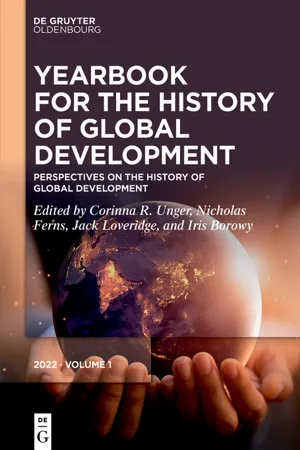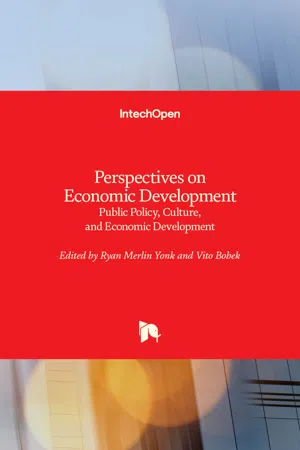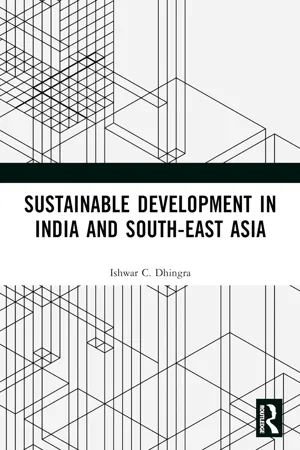Economics
Measures of Development
Measures of development in economics refer to the various indicators used to assess the progress and well-being of a country or region. These measures can include GDP per capita, life expectancy, literacy rates, and access to basic services. By analyzing these indicators, economists can gauge the overall development level of a country and identify areas for improvement.
Written by Perlego with AI-assistance
Related key terms
1 of 5
7 Key excerpts on "Measures of Development"
- Eckhard Siggel(Author)
- 2016(Publication Date)
- Routledge(Publisher)
Chapter 1 Economic Development: Concept and MeasurementMany economic concepts are widely used but rarely defined with some degree of precision. Economic development is one of these concepts. Its meaning is best apprehended by comparison with economic growth and by thinking about its measurement. The present chapter is devoted to defining these concepts and to discussing their measurement. The attempt to define development and growth in sections 1.1 and 1.2 is followed by a discussion of the income distribution and poverty in section 1.3 , and an examination of the problems arising in international comparisons of income levels in 1.4 . The chapter concludes with a short discussion of composite development indicators, notably the Human Development Index, which is examined in more detail in the first of our case studies. The other two case studies of this chapter deal with the purchasing power parity (PPP) approach to international income comparisons, as well as with an approach to overcome certain problems in deflating the national accounts.1.1 The Concept of Economic Development
Economic development is understood to be a process, which leads a country from a state of underdevelopment, characterized by low income and a poor quality of life, to one of higher living standards for a large majority of its people. This rather general definition has a normative connotation, since it describes development as a desirable process, the outcome of which is an increased level of welfare. Its disadvantage lies in its generality, leaving open the question of how exactly the level of development is to be measured. More specific indicators exist, but they tend to narrow down the concept of development. It is therefore necessary to apply several, rather than only one measure.- eBook - PDF
Development Economics
Theory and Practice
- Alain de Janvry, Elisabeth Sadoulet(Authors)
- 2021(Publication Date)
- Routledge(Publisher)
CHAPTER ONE What Is Development? Indicators and Issues S EVEN D IMENSIONS OF D EVELOPMENT Development is about the enhancement of human wellbeing. Because wellbeing is a highly multidimensional concept, defining development requires making a statement about the social needs and aspirations of the corresponding individual, group, class, or nation. Few would disagree with the generic statement that “development” is preferable to “underdevelopment.” At the same time, there is considerable disagreement across individuals and nations as to what is meant by development and, once agreed on what it is, how it is to be achieved. Development is one thing for some and another for others. Some put achieving a rapid rate of economic growth as the main objective. This characterizes countries like postwar Japan and China, which pursued neo-mercantilist models with low-priced exports driving economic growth. In their debate on how to reduce poverty in India, Bhagwati and Panagariya (2013) argue that the main instrument is more rapid economic growth facilitated by further trade liberalization and an improved investment climate, notably in terms of labor laws and landownership. Others give a great deal of importance to maintaining low inequality. This is the case in the Nordic countries and Japan in the more recent period, heavily taxing high incomes to level out social inequalities through transfers. The World Bank’s (2005) World Development Report 2006 made the case that lowering inequality is a factor of not only reduced poverty but also, in the long run, accelerated economic growth. Others place a great deal of importance on securing access to basic needs for all, with comprehensive coverage of publicly provided health, education, and pension services. This perspective on the role of the state in delivering a universal minimum basic-needs coverage applies to much of continental Europe and Canada. - Corinna R. Unger, Nicholas Ferns, Jack Loveridge, Iris Borowy, Corinna R. Unger, Nicholas Ferns, Jack Loveridge, Iris Borowy(Authors)
- 2022(Publication Date)
- De Gruyter Oldenbourg(Publisher)
II Measuring Development (ed. Corinna R. Unger and Jack Loveridge)The Historiography of Measuring Development
Stephen Macekura“Statistics must always have a purpose,” wrote the Indian planner Prasanta Chandra Mahalanobis in 1965. For the man whose economic models informed India’s second Five Year Plan, the purpose was clear. Statistics were the “essential information required to prepare the plans of economic development.” They also served tools for “assessing the progress” of those plans, and experts could adjust their strategies based on new data that they collected. In other words, statistics were constitutive of the entire project of India’s development, just as they were for all other countries. Because of the centrality of measurement to global development aspirations, Mahalanobis foresaw an “increasing demand for statistics” long into the future to “bring in the new age of peace, prosperity, and progress of the world.”1 Mahalanobis’ claims about the power of statistics contain valuable insights for the historian of international development. To study the measurement of development is to study development itself. After all, how can one understand development if it is not measured, quantified, and assessed?Across the twentieth century world, experts debated how development should be measured. The dominant metrics were those associated with national income accounting, such as Gross National Product (GNP) and later Gross Domestic Product (GDP).2 This was true for national economic policy and international development. For much of the twentieth century, national leaders and many experts equated economic growth measured by GNP as evidence of development. The German-British economist Hans Singer noted that a belief in the power of GNP growth as an economic cure-all “enabled economists to transfer familiar concepts and familiar modes of thinking to the relatively new but rapidly emerging problems of the Third World,” assuming a “trickle-down” effect would be a solvent for political and social strife.3- eBook - PDF
Perspectives on Economic Development
Public Policy, Culture, and Economic Development
- Ryan Merlin Yonk, Vito Bobek, Ryan Merlin Yonk, Vito Bobek(Authors)
- 2020(Publication Date)
- IntechOpen(Publisher)
However, major criticisms have been raised against using GDP as a measure 63 of economic and social welfare, particularly among scholars in the field on environ-mental economics. This literature has been arguing for modification of GDP to include resource depletion and environmental degradation associated with eco-nomic growth in a context of sustainable development. The World Bank has adopted and started measuring the so-called genuine savings indicator developed by Pearce and Atkinson [1] and the genuine progress indicator (GPI), as measures of sustainable development. Yet, a massive body of literature had been developing arguing that economic growth is the only way to protect the environment, in the context of the so-called environmental Kuznets curve. Since the early 1990s, the UN Development Programme has adopted and started measuring the human develop-ment index pioneered by Sen and Haq. The HDI encompasses measures of eco-nomic, health, and education and ranks countries in a scale of 100 points according to their achievements in these dimensions. All these measures have been developed in lines of calls sustainable development following the World Commission on Envi-ronment and Development Report in 1987 and the Agenda 21 adopted in Rio 1991. In 2000, the world nations adopted the Millennium Development Goals (MDGs). The agreed MDGs had to be achieved by 2015. Many low-income countries failed to achieve the targets, while the world nations went forward to adopt the Sustainable Development Goals (SDGs) to be achieved by 2030. In the light of their progress to achieve the MDGs, low-income countries are unlikely to move forward to make progress in achieving the SDGs in a matter of 10 years. However, SDGs remain a guide to economic, social, and environmental policies in all countries but particu-larly in low-income countries. - eBook - ePub
Global Development
The Basics
- Daniel Hammett(Author)
- 2023(Publication Date)
- Routledge(Publisher)
3Understanding and measuring development
DOI: 10.4324/9781003155652-3As our understandings of global development have shifted, so too have the ways in which development is defined and measured. Economics-based approaches have generally held sway over Western attitudes to development – however, these approaches have increasingly been challenged by moves towards more holistic understandings. At the same time, there has been growing sensitivity to ‘alternative’ and indigenous understandings of development, many of which pre-date dominant Western approaches.Infusing the debates outlined in this chapter are differing agendas and ideologies which, in turn, produce different sets of priorities and measures for development. At the crux of the tensions between different approaches to and theories of development are differing beliefs as to not only what ‘development’ is but also what is ‘worthwhile’ development, and what can be learnt from experiences when development agendas produce negative or bad outcomes.Development as economic growth
Mainstream global development policies and donors continue to focus on economic growth (driven by industrialisation) as the primary route to poverty reduction and the realisation of development goals. This approach is evident in the work of influential figures including Paul Collier and Jeffrey Sachs. Drawing on Keynesian economics, Collier (2008) argues we should be less worried about the type of economic growth than about the absolute level or amount of growth. His argument is, in essence, that high levels of economic growth will de facto drive poverty reduction and development and he points to the slow economic growth rate of the poorest countries as evidence for this. Meanwhile, Jeffrey Sachs’ (2005) - Ishwar C. Dhingra(Author)
- 2023(Publication Date)
- Routledge(Publisher)
2 Economic Development: Concept and Measurement2.1 Introduction
A comparative study of nation states in South-East Asia and India need not be pursued in vacuum. We need to have a sound conceptual framework within whose dimensions an objective analysis can be pursued. We intend to present such a framework that will focus on the concept of economic development. We will also highlight the different criteria of development, besides Gross Domestic Product. We will conclude the chapter with an identification of criteria that can be used for purpose of comparison of countries at different levels of development.2.2 Meaning of Economic Development
A decision tree, such as the one in Fig. 2.1 below, can help identify the biggest obstacles to growth. A concerted effort on all these fronts is required to attain economic development. But, what is economic development?Fig. 2.1: Problem: Low Levels of Private Investment and Entrepreneurship.2.2.1 ‘Development’ Distinguished from ‘Growth’
Traditional View Traditionally, economic development has been considered as synonymous with economic growth. Economic growth has been defined as “an increase in real terms of the output of goods and services that is sustained over a long period of time, measured in terms of value added.” While National Income estimated at Current Prices (NICUP) is called nominal income, national income estimated at constant prices (NICOP) is called real national income.Modern View The traditional concept of viewing economic development as synonymous with economic growth was based on what came to be known as the “trickle-down strategy- eBook - PDF
Less Pretension, More Ambition
Development Policy in Times of Globalization
- Peter van Lieshout, Robert Went, Monique Kremer(Authors)
- 2010(Publication Date)
- Amsterdam University Press(Publisher)
Global changes are more impor-tant at political, economic and technical levels (improvements in antibiotics or water pumps have influenced the lives of a lot of people more than economic growth). It is, of course, possible to devise more complex criteria which would be more satisfying from a substantive point of view. There is a good reason why the oecd is carrying out a major project with the splendid title of Measuring the progress of societies , and why the French President Sarkozy set up the Commission on the Measurement of Economic Performance and Social Progress in 2008, under the chairmanship of Nobel Prize Winner Joseph Stiglitz, with the explicit task of exploring the options for a better indicator than gdp (see also Manning 2009). It is clear, however, that – at least for the time being – it is not going to be possible to find an indicator which is usable and acceptable to everyone. In its report, the commission advocates dashboards of indicators which would allow various people and institutes to combine indicators as they see fit to monitor development of matters they regard as a priority (Stiglitz et al. 2009). 4.2 what does aid contribute? It is tempting to interpret improvements, particularly those of measured social indicators, as an indication of the usefulness of development aid. The question is to what extent this is justified. A great deal of research has been devoted to this issue. At first sight the research design also appears to be straightforward: compare countries with varying levels of development aid and assess the outcome. That approach has resulted in a series of comparative country studies. There is a serious problem, however, in that countries cannot simply be compared. The following is a case in point. It is popular to compare Ghana and South Korea. It features in many a study of development aid, because in 1960 both countries had a compara-ble gdp per capita, while in 2008 it differed by a factor of eighteen.
Index pages curate the most relevant extracts from our library of academic textbooks. They’ve been created using an in-house natural language model (NLM), each adding context and meaning to key research topics.






